|

Weights and Measures: Guinea pigs are large for rodents, weighing between 0.5 (as juveniles) and 1.5 kg (1–3 pounds), and measuring 25–40 cm (10–15 inches) long.

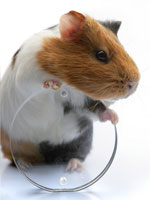 Long Live the Guinea Pig: They live an average of four to eight years. According to the 1997 Guinness Book of Records the longest living Guinea pig lived 15 years. They are social, living in the wild in small groups which consist of sows (females), a boar (male), and the young. Long Live the Guinea Pig: They live an average of four to eight years. According to the 1997 Guinness Book of Records the longest living Guinea pig lived 15 years. They are social, living in the wild in small groups which consist of sows (females), a boar (male), and the young.
Mated for life: Unlike similar rodents, Guinea pigs mate for life in the same pair bond. Domesticated Guinea pigs thrive in groups of two or more. Groups of boars may also get along, provided their cage has enough space, they are not introduced to a female (most of the time), and proper introduction techniques are employed.
Males are from Mars... Some guinea pig owners report that female guinea pigs are more docile than their male counterparts, although each guinea pig is different.
Wild State: In their wild state, Guinea pigs are found on grassy plains and occupy an ecological niche similar to that of the cow. They move together in small groups (herds) eating grass or whatever other plants they come across. They are crepuscular, tending to be most active during dawn and dusk, when it is harder for predators to spot them. If startled they can run for cover with surprising speed. Domestic animals have developed a different rhythm, and have longer periods of activity followed by short periods of sleep in between. Activity is scattered randomly over the 24 hours of the day.
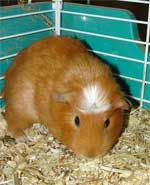 Guinea Grotto: Domestic guinea pigs generally live in cages. Cages with wire mesh floors are not recommended by guinea pig owners as these can cause injury and may be associated with a foot infection commonly known as "bumblefoot" (ulcerative pododermatitis). Guinea Grotto: Domestic guinea pigs generally live in cages. Cages with wire mesh floors are not recommended by guinea pig owners as these can cause injury and may be associated with a foot infection commonly known as "bumblefoot" (ulcerative pododermatitis).
Cages are often lined with wood shavings or a similar material. Bedding made from red cedar and pine, both softwoods, were commonly used in past decades but are now believed to contain harmful phenols (aromatic hydrocarbons) and oils (particularly red cedar).
Many retail stores and manufacturers still advertise softwood beddings as safe for guinea pigs, but there is growing pressure to stop the practice. Safer beddings include those made from hardwoods (such as aspen), hemp, paper, or grain. A new idea for bedding is the practice of lining the cage with newspaper or another absorbent material and covering it with fleece. This is cheaper than standard beddings, and easier to clean. "Cubes and Coroplast" (or C&C) style cages are now a common choice.
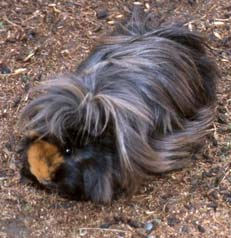 Athletes They Are Not: Unlike many rodents such as mice, rats, or squirrels, guinea pigs are not very athletic, although they require ample space to run, jump, play, hide and rest. Jumping gaps, climbing, and fearlessness in the face of heights were not skills guinea pigs needed in their natural environment, although they can hop over small obstacles with agility. Athletes They Are Not: Unlike many rodents such as mice, rats, or squirrels, guinea pigs are not very athletic, although they require ample space to run, jump, play, hide and rest. Jumping gaps, climbing, and fearlessness in the face of heights were not skills guinea pigs needed in their natural environment, although they can hop over small obstacles with agility.
When excited, Guinea pigs tend to do little jumps in the air (known as "popcorning"). Even so, they can perform feats such as climbing stairs, of certain heights, if prompted.
Guinea pigs are vocal animals, with a fairly large vocabulary. Some sounds are:
The "Wheek". A loud noise that sounds about the same as its written form. An expression of general excitement, it can mean "feed me", "pay attention", or possibly "I'm hurt". It is sometimes used to find other guinea pigs if they are in a run. If a guinea is lost, it may "wheek" for assistance.
"Rumbling". This sound is related to Guinea pig dominance or in response to an unfamiliar sound. It can also come as a response to comfort or content. Whilst courting, a male usually purrs deeply, while swaying from side to side, nearly lifting the rear feet.
"Chattering". This sound is made by rapidly gnashing the teeth together — it's a warning to others to keep away. Guinea pigs tend to raise their heads when making this sound so as to look more dangerous.
"Tribbling" "Bubbling" or "Purring". This rather pleasant sound is made when the guinea pig is enjoying itself, usually when being petted or brushed. They may also make this sound when grooming, crawling around to investigate a new place, or when given an unexpected food 'treat' like lettuce or carrots.
"Popcorning". "Popcorning" refers to a particularly loud "wheek" that is accompanied by a hop, either high or short. A guinea pig that "popcorns" is feeling full of energy, or is very pleased.
Vitamins for Rodents: Like humans but unlike most other mammals, guinea pigs cannot synthesize their own vitamin C and must obtain this vital nutrient from food. Also like humans, if guinea pigs cannot get enough vitamin C they will suffer from scurvy and ultimately die. Guinea pigs require about 25-50mg of vitamin C daily, which can be obtained through fresh, raw fruits and vegetables or through supplements fed to domestic animals. Guinea pigs often learn to enjoy these tablets, eating them from their owners' hands.
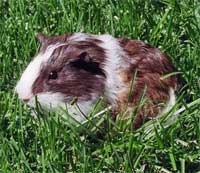
Grass Lovers: Grass is the guinea pig's natural diet. Grass digestion requires a special digestive system; whereas most grass-eating mammals are quite large and have a long digestive tract, guinea pigs use a more unusual method, practicing coprophagy, the eating of their own feces.
However, they do not consume their feces indiscriminately.
They produce special soft pellets, called "cecotropes", which contain the B vitamins and bacteria required for proper digestion. These pellets are not the same as regular feces. They share this behavior with rabbits.
Hay Eaters: Guinea pigs benefit from feeding on grass hay such as timothy hay in addition to food pellets. Hay provides roughage and long-strand fiber needed in their diet which pellets alone do not provide. Alfalfa hay, a legume hay richer in calcium and protein, is available either fresh or in the form of pellets (the most common pellet-based feed available). Experts recommend that alfalfa and other foods rich in calcium, (such as spinach), be fed to adults only in moderation.[citation needed] Diets with imbalanced Ca:P ratios may result in health problems and may possibly contribute to the formation of certain types of bladder stones and bladder sludge. A number of brands of commercially prepared pellets exist that are based on dehydrated timothy hay, which are ideally suited for guinea pigs over six months that are not pregnant or lactating.
Beware These Plants: A number of plants are poisonous to guinea pigs, including bracken, buttercup, bryony, charlock, deadly nightshade, hemlock, lily of the valley, privet, scarlet pimpernel, ragwort, various parts of the potato plant, toadflax and tomato leaves. Additionally, any plant which grows from a bulb e.g., tulip and onion is normally considered poisonous. Guinea pigs are also known to consume large amounts of cloth (bed sheets, clothing, shoe laces) or even plastic, such as insulation around electrical cords. Surprisingly, they can usually withstand consuming such materials; although they are not recommended by owners for obvious reasons.
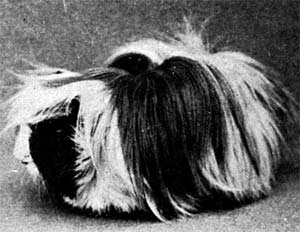
Health: Guinea pigs need to be seen by a veterinarian like any other pet. A vet treating a guinea pig needs to be familiar with the animal; many antibiotic medications, including those that are penicillin based, are toxic to guinea pigs.
Common ailments: Common ailments in domestic guinea pigs include respiratory infections, diarrhea, scurvy (vitamin C deficiency, symptoms include hind leg paralysis), abscesses (large amounts of a thick pus that create a bulge, often in their neck, due to infected internal scratches from hay that is too hard or infected external scratches received in a variety of ways), and infections by lice, mites or fungus.
Mange mites: Mange mites (Trixacarus caviae) are a common cause of fur loss, whose symptoms also may include excessive scratching, unusually aggressive behavior when touched (due to pain), and in some instances, seizures. If not treated, mange mites can be fatal.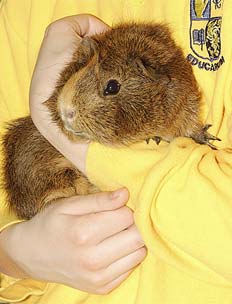
Invisible Mites: Mange mites are not visible to the naked eye. Vets may perform a "skin scraping" to determine the presence of mites (or a fungal infection), although this procedure is often painful and may result in a false negative result. Mange mites are commonly treated with several doses of ivermectin, available through a veterinarian.
Running lice: Guinea pigs may also suffer from "running lice" (Gliricola porcelli) a small white insect which can be seen running through fur. Ivermectin or Advantage (imidacloprid), are often used to treat these and other types of lice.
Guinea pigs are "prey animals" whose survival instinct is to mask pain and signs of illness, and many times signs of illness may not be apparent until a problem is severe or in its advanced stages. Common early symptoms of problems are:
* Lethargy (reduced activity)
* Blood present in cage or on animal
* Sitting in a hunched position with fur puffed out
* Discharge from eyes (see note below), nose or ears
* Raspy-sounding vocalizations
* Wheezing or difficulty breathing
* Limping
* Diarrhea
* Lack of feces output
* Head tilt or loss of balance (may indicate an ear infection)
* Wheeking while urinating
* Sensitivity to touch
* Fur loss
* Excessive scratching
* Weight loss
* Rapid weight gain/shifting of bodily weight
Guinea pigs normally secrete a milky-white fluid near their eyes. Upon secretion of this fluid, the cavy will usually raise his front paws and groom himself.

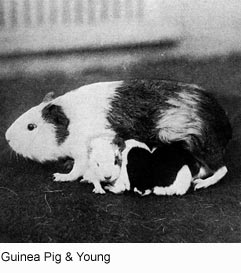 Forever Fertile: Males are not known to attack their own pups. However, females can become pregnant in less than 12 hours after giving birth, and it is not healthy for a female sow to be in virtually a constant state of pregnancy. Cohabitating females may assist in mothering duties. Forever Fertile: Males are not known to attack their own pups. However, females can become pregnant in less than 12 hours after giving birth, and it is not healthy for a female sow to be in virtually a constant state of pregnancy. Cohabitating females may assist in mothering duties.
Eggplant-shaped Moms to Be: Because of the long gestation period and the large size of the pups, pregnant females may become large and eggplant-shaped, although the change in size and shape varies among individual animals. Breeding males produce a strong musk that smells much like beeswax.
All text is available under the terms
of the GNU Free Documentation License
|